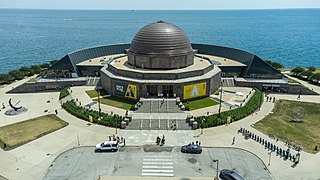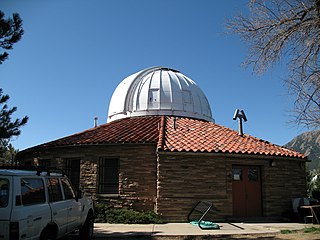
The Adler Planetarium is a public museum in Chicago, Illinois, dedicated to astronomy and astrophysics. It was founded in 1930 by local businessman Max Adler. Located on the northeastern tip of Northerly Island on Lake Michigan, the Adler Planetarium was the first planetarium in the United States. It is part of Chicago's Museum Campus, which includes the John G. Shedd Aquarium and The Field Museum. The Planetarium's mission is to inspire exploration and understanding of the universe.

Yerkes Observatory is an astronomical observatory located in Williams Bay, Wisconsin, United States. The observatory was operated by the University of Chicago Department of Astronomy and Astrophysics from its founding in 1897 to 2018. Ownership was transferred to the non-profit Yerkes Future Foundation (YFF) in May 2020, which began restoration and renovation of the historic building and grounds. Re-opening for public tours and programming began May 27, 2022.

The Lick Observatory is an astronomical observatory owned and operated by the University of California. It is on the summit of Mount Hamilton, in the Diablo Range just east of San Jose, California, United States. The observatory is managed by the University of California Observatories, with headquarters on the University of California, Santa Cruz campus, where its scientific staff moved in the mid-1960s. It is named after James Lick.

The Mount Wilson Observatory (MWO) is an astronomical observatory in Los Angeles County, California, United States. The MWO is located on Mount Wilson, a 5,710-foot (1,740-meter) peak in the San Gabriel Mountains near Pasadena, northeast of Los Angeles.

The Cerro Tololo Inter-American Observatory (CTIO) is an astronomical observatory located on the summit of Mt.Cerro Tololo in the Coquimbo Region of northern Chile, with additional facilities located on Mt. Cerro Pachón about 10 kilometres (6.2 mi) to the southeast. It is approximately 80 kilometres (50 mi) east of La Serena, where support facilities are located. The site was identified by a team of scientists from Chile and the United States in 1959, and it was selected in 1962. Construction began in 1963 and regular astronomical observations commenced in 1965. Construction of large buildings on Cerro Tololo ended with the completion of the Víctor Blanco Telescope in 1974, but smaller facilities have been built since then. Cerro Pachón is still under development, with two large telescopes inaugurated since 2000, and one in the final stages of construction as of 2023

The Dominion Astrophysical Observatory, located on Observatory Hill, in Saanich, British Columbia, was completed in 1918 by the Canadian government. The Dominion architect responsible for the building was Edgar Lewis Horwood. The main instrument is the 72-inch-aperture (1.83 m) Plaskett telescope, proposed and designed by John S. Plaskett in 1910 with the support of the International Union for Cooperation in Solar Research.

The Center for Astrophysics | Harvard & Smithsonian (CfA), previously known as the Harvard–Smithsonian Center for Astrophysics, is an astrophysics research institute jointly operated by the Harvard College Observatory and Smithsonian Astrophysical Observatory. Founded in 1973 and headquartered in Cambridge, Massachusetts, United States, the CfA leads a broad program of research in astronomy, astrophysics, Earth and space sciences, as well as science education. The CfA either leads or participates in the development and operations of more than fifteen ground- and space-based astronomical research observatories across the electromagnetic spectrum, including the forthcoming Giant Magellan Telescope (GMT) and the Chandra X-ray Observatory, one of NASA's Great Observatories.

Goldendale Observatory State Park is an educational facility on the northern side of Goldendale, Washington, notable for its unusually large public telescope. The state park occupies five acres (2.0 ha) atop a 2,100-foot (640 m) hill.
The Astronomical Observatory of Belogradchik or Belogradchik Observatory is an astronomical observatory owned and operated by the Institute of Astronomy of the Bulgarian Academy of Sciences. It is located near the town of Belogradchik in northwestern Bulgaria, at the foot of the Western Balkan Mountains. The other observatory operated by the same institute is the Rozhen Observatory.

Mount Laguna Observatory (MLO) is an astronomical observatory owned and operated by San Diego State University (SDSU). The telescope was operated in partnership with the University of Illinois at Urbana-Champaign (UIUC) until 2000. MLO is located approximately 75 kilometers (47 mi) east of downtown San Diego, California (USA) on the eastern edge of the Cleveland National Forest in the Laguna Mountains on the SDSU Astronomy Campus near the hamlet of Mount Laguna. MLO was dedicated on June 19, 1968, seven years after SDSU's Department of Astronomy became an independent academic department of SDSU's College of Sciences. The dedication took place during the 1968 summer meeting of the Astronomical Society of the Pacific. Currently SDSU is working with University of Kansas (KU), and UNC Chapel Hill on various projects.

Konkoly Observatory is an astronomical observatory located in Budapest, Hungary is part of the Research Centre for Astronomy and Earth Sciences and belongs to the Eötvös Loránd Kutatási Hálózat. It was founded in 1871 by Hungarian astronomer Miklós Konkoly-Thege (1842–1916) as a private observatory, and was donated to the state in 1899. Konkoly Observatory, officially known as ELKH CSFK Konkoly Thege Miklós Csillagászati Intézet in Hungarian, is the largest astronomical research institute in Hungary, and hosts the largest telescopes in the country. The Observatory has more than 60 researchers, a quarter of them are non-Hungarian.

Sommers–Bausch Observatory is an astronomical observatory located on and owned by University of Colorado Boulder. The building was initially completed in 1953 and named after Elmer E. Sommers and Carl L. Bausch.
Stull Observatory is an astronomical observatory owned and operated by Alfred University located in Alfred, New York (USA) and named after John Stull, who helped establish the observatory in 1966. It is notable for housing seven independently housed telescopes ranging in size from 8 to 32 inches. The largest, the Austin-Fellows 32 inch Newtonian Reflector is tied with the Vassar College Class of 1951 Observatory for the rank of second largest optical telescope in New York state after the 40 inch telescope at SUNY Oneonta College Observatory. Telescopes at the observatory are regularly opened to the public. The observatory is also used for those pursuing a minor in astronomy or a concentration in astrophysics.

The Hirsch Observatory is an astronomical observatory at Rensselaer Polytechnic Institute (RPI) in Troy, New York. It is located on the roof of the Jonsson-Rowland Science Center and is used by members of the Rensselaer Astrophysical Society as well as astronomy students in laboratory exercises. It is frequently opened to the community for public viewing sessions. The observatory's main dome contains a 16" Cassegrain Reflector, with a CCD camera and fully computerized controls. The observatory also owns a variety of smaller scopes and a SBIG Spectrograph. The spectrograph has been used to catalog bright solar spectrum as part of an effort to create an online digital database for astrophysical research. The current director of the observatory is Professor Heidi Newberg.

The Dearborn Observatory is an astronomical observatory located on the Evanston campus of Northwestern University. The observatory was originally constructed in 1888, through an agreement between the university and the Chicago Astronomical Society. In the summer of 1939, Dearborn Observatory had to be moved to make way for the construction of the Technological Institute.

The Kenwood Astrophysical Observatory was the personal observatory of George Ellery Hale, constructed by his father, William E. Hale, in 1890 at the family home in the Kenwood section of Chicago. It was here that the spectroheliograph, which Hale had invented while attending MIT, was first put to practical use; and it was here that Hale established the Astrophysical Journal. Kenwood's principal instrument was a twelve-inch refractor, which was used in conjunction with a Rowland grating as part of the spectroheliograph. Hale hired Ferdinand Ellerman as an assistant; years later, the two would work together again at the Mount Wilson Observatory.

The Givatayim Observatory is a public observatory that was founded in 1968 by the Israeli Astronomical Association and the Givatayim municipality.
Corralitos Observatory was an astronomical observatory located in the Rough and Ready Hills approximately 30 kilometers (19 mi) west of Las Cruces, New Mexico. It was formally dedicated on October 12, 1965, serving as a remote station of Dearborn Observatory, Northwestern University. In October 1965, a NASA program to detect transient lunar phenomenon (TLP) was begun by the staff. Using two-person observer teams, a total of 6,466 man-hours of lunar observation was recorded. The program was run until 1972 but did not confirm any TLP. Using ninety-eight selected reports of TLPs received from amateurs during this period, 39 were checked from Corralitos Observatory.

The Prairie Observatory was constructed near Oakland, Illinois by the University of Illinois at Urbana-Champaign's Department of Astronomy. The site was adjacent to Walnut Point State Park and provided an accessible but dark sky site only 35 miles from campus. The telescope went into operation in January 1969 and closed on April 1, 1981.

UCL Observatory at Mill Hill in London is an astronomical teaching observatory. It is part of the Department of Physics and Astronomy at University College London.






















